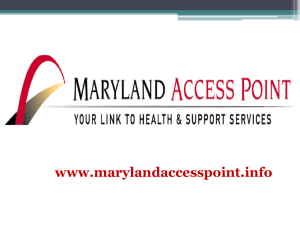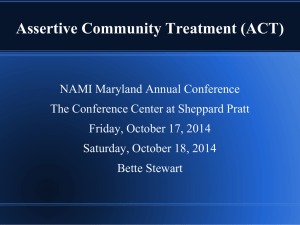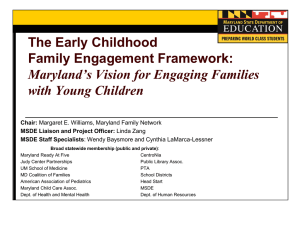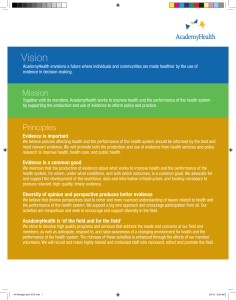What`s Next for Maryland?
advertisement
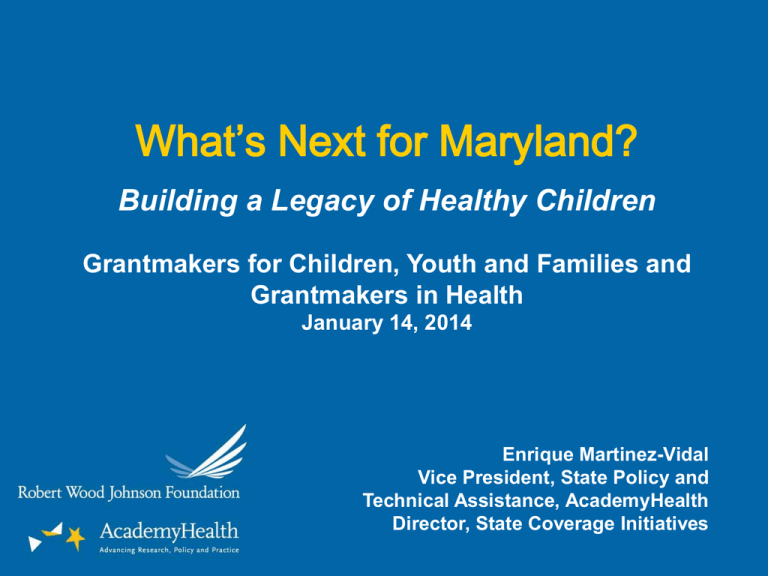
What’s Next for Maryland? Building a Legacy of Healthy Children Grantmakers for Children, Youth and Families and Grantmakers in Health January 14, 2014 Enrique Martinez-Vidal Vice President, State Policy and Technical Assistance, AcademyHealth Director, State Coverage Initiatives AcademyHealth: Improving Health & Health Care AcademyHealth is a leading national organization serving the fields of health services and policy research and the professionals who produce and use this important work. Together with our members, we offer programs and services that support the development and use of rigorous, relevant and timely evidence to: – Increase the quality, accessibility and value of health care, – Reduce disparities, and – Improve health. A trusted broker of information, AcademyHealth brings stakeholders together to address the current and future needs of an evolving health system, inform health policy, and translate evidence into action. Presentation Overview • Maryland Landscape Overview • Maryland Health Reform Activities • Lessons from Previous Reforms • Ingredients Needed for Reform • What Roles Can Philanthropy Play? Maryland Has 5.9 Million People Source: Map prepared by the Maryland Department of Planning, from the U.S. Census Bureau. Maryland is Racially & Ethnically Diverse Maryland is an Affluent State With Pockets of Poverty Garrett 12.0% Allegany 19.1% Washington 11.8% Frederick 6.6% Carroll Baltimore Harford 5.5% County 8.3% 9.6% Howard 6.0% Montgomery 6.7% Baltimore City 24.5% Anne Arundel 6.1% Prince George’s 9.4% Charles 7.7% Cecil 9.7% Kent 13.9% Queen Anne’s 8.7% Caroline 13.1% Talbot 10.8% Calvert 6.1% St. Mary’s 8.6% Dorchester 17.5% Wicomico 17.7% Worcester 13.0% Somerset 26.2% Source: Bureau of the Census, Small Area Income and Poverty Estimates. Many Residents Are Insured, But Not All Source: U.S. Census Bureau and the Centers for Disease Control and Prevent. SAHIE/State and County by Demographic and Income Characteristics, 2010. County Health Rankings Correspond to Uninsured Rates Source: University of Wisconsin Population Health Institute. County Health Rankings 2013. County Health Rankings & Roadmaps: A Healthier Nation, County by County. 2013 Rankings: Maryland. Maryland Coverage Statistics (2011-12) Nonelderly Adult - % Employer Other private Medicaid Other public Uninsured Total Nonelderly Adult - # Children - % Children - # 65% 3,286,900 59% 843,000 5% 258,700 4% 51,700 13% 663,500 27% 383,000 2% 106,200 -- 15% 755,900 9% 128,000 100% 5,071,200 100% 1,428,900 Source: Analysis of the Census Bureau’s March Supplement to the Current Population Survey (the CPS Annual Social and Economic Supplement or ASEC) by the Kaiser Commission on Medicaid and the Uninsured and the Urban Institute. -- Health Reform Strategic Approach Five Key Components Five Key Initiatives 1. Promote access to care Exchange/Medicaid expansion 2. Promote wellness & community health through public health/medicine integration State Health Improvement Process 3. Address pockets of intense health disparities Health Enterprise Zones 4. Reform incentives for hospitals Modernizing the Waiver 5. Use mapping, hot-spotting, and data analysis to support robust primary care and community outreach The State Innovation Model Source: Health Systems and Infrastructure Administration, Maryland Department of Health and Mental Hygiene. Maryland Coverage Initiatives: Exchange • 5 carriers in individual market: 45 plans − 36 include embedded pediatric dental benefits − 20 stand-alone dental plans by 4 dental carriers o 8 plans offer pediatric dental benefits only o 12 plans offer family coverage o All plans are offered statewide • Small group market (SHOP): not launched yet • Benefit Plan − Small group market plan, supplemented with: − Pediatric Oral (State CHIP) − Pediatric Vision (FEDVIP) − Plans required to cover habilitative services benefits for members age 19 and above in parity with benefits covered for rehabilitative services. Source: Maryland Health Benefit Exchange. Consumer Outreach/Education/Assistance • • • • • • • Branding, Marketing and Advertising Outreach and Education Web Portal/On-line Communications Navigators/In-person Assisters Brokers (2,000+) Customer Service Center Decision Support Tools Maryland Health Benefit Exchange: Six Connector Entities Source: Maryland Health Benefit Exchange. Estimates of 2014 ACA Enrollment for Maryland • • • • • • • Medicaid Expansion (Includes PAC Enrollees) Medicaid "Woodwork" Effect Exchange (138-200% FPL) with Subsidy Exchange (200-400% FPL) with Subsidy Exchange (Above 400% FPL) without Subsidy Small Business Health Options Program (SHOP) Total New Medicaid and Exchange Coverage Source: Hilltop Institute, UMBC. 7/13/12. 90,639 11,046 37,452 67,289 34,023 8,469 248,918 Maryland Coverage Initiatives: Exchange and Medicaid Expansion As of 1/4/14: 162,000 Marylanders are on track to receive health coverage under ACA • 20,358 into Qualified Health Plans • 91,570 moved into Medicaid from Primary Adult Care (PAC) program • 50,522 found eligible for Medicaid program through Exchange – 26,500 now enrolled/remainder on track (retro to 1/1) Source: Maryland Health Benefit Exchange, January 10, 2014. State Health Improvement Process (SHIP) • Framework and resources to align local action to continuously improve population health/health equity • 18 Local Health Improvement Coalitions − Typically co-chaired by hospital and public health leaders and include cross-section of health and human services • State and Local Accountability − 39 measures: health outcomes and determinants − State and county baselines and 2014 targets − Racial/ethnic disparity information Source: Health Systems and Infrastructure Administration, Maryland Department of Health and Mental Hygiene. 18 Local Health Improvement Coalitions (LHICs) Across Maryland Source: Health Systems and Infrastructure Administration, Maryland Department of Health and Mental Hygiene. The Role of LHICs in Community Health Improvement Today • Convening/facilitating/coordinating • Planning and priority-setting • Performance monitoring Source: Health Systems and Infrastructure Administration, Maryland Department of Health and Mental Hygiene. Aligned Action in 6 Focus Areas to Increase Life Expectancy Healthy Babies Infectious Disease Reduction Healthy Social Environments Prevent and Control Chronic Disease Safe Physical Environments Improve Health Care Access Source: Health Systems and Infrastructure Administration, Maryland Department of Health and Mental Hygiene. What is the Health Enterprise Zone (HEZ) Initiative? • A project of the Lt. Governor, Department of Health and Mental Hygiene, and Maryland Community Health Resources Commission • Aims to reduce chronic diseases among ethnic groups that are more likely to suffer from these illnesses • Over the next four years, will provide up to $16 million to fund five HEZ programs across the state – – – – – MedStar St. Mary’s Hospital, Greater Lexington Park Dorchester County Health Department, Competent Care Connections Prince George’s Health Department, Capitol Heights Anne Arundel Health System, Annapolis Bon Secours Baltimore Health System, West Baltimore Primary Care Access Collaborative HEZ Initiative Goals • Improve health outcomes for people with chronic illnesses • Increase the number of primary care professionals in underserved communities • Increase the number of community members involved in promoting health • Increase healthy options in underserved communities • Reduce preventable emergency department visits and hospitalizations for people with chronic illness • Reduce health care costs of people with chronic illness Source: PowerPoint presentation by Novella Tascoe at AcademyHealth’s meeting on Delivery Systems Meeting: Transforming Health and Health Care – Focus on Maryland, June 21, 2013. Example: Greater Lexington Park HEZ Main Activities/Goals • Integrated Care Team Model in the HEZ • Culturally Competent HEZ Healthcare Environment • Community-based Clinical Care Coordinators • Evidence-based Community Health Worker Program • HEZ Medical Transportation Route • Mobile Dental Clinic • Lexington Park Community Health Center Source: PowerPoint presentation by Joan Gelrud at AcademyHealth’s meeting on Delivery Systems Meeting: Transforming Health and Health Care – Focus on Maryland, June 21, 2013. Example: West Baltimore Primary Care Access Collaborative HEZ • A group of sixteen federally-qualified health centers, hospitals, community-based organizations, and academic institutions • Aims to reduce cardiovascular disease (CVD) in West Baltimore ZIP Codes 21216, 21217, 21223, 21229 • Creates an independent organization, West Baltimore CARE (Community Asset & Resource Exchange) to target 86,000 residents for health and social services to reduce CVD – – – – Strengthens the Community Improves Health Outcomes Enhances Quality of Heath Care Saves Health Care Costs Source: PowerPoint presentation by Novella Tascoe at AcademyHealth’s meeting on Delivery Systems Meeting: Transforming Health and Health Care – Focus on Maryland, June 21, 2013. West Baltimore CARE (Community Asset & Resource Exchange) Center for Quality PCMH Progress Monitoring Technical Assistance HEZ Data Collection & Reporting Center for Community Enrichment Outreach Team (11) Disease Management Classes Health Education Classes Center for Primary Care and Workforce Development Primary Care Workforce Assessment Primary Care Professional Recruitment Quality Improvement Medical and Social Service Referrals Incentive Programs HEZ Program Implementation Oversight Health Promotion Campaigns WBPCAC Employee Orientation Food Retailer Partnerships Internships Evidence Base Assessment Research CARE Performance Evaluation IT Coordination and Support Provider Training Group Fitness Classes Scholarships Community Fitness Venues CHW Training Community Health Events Care Team Training HEZ Program Development Care Coordination Training Disease Management Curriculum Development Student and Community Health Advocate Recruitment & Training Technical Assistance Curriculum Development Technical Assistance PCMH Technical Assistance CMMI State Innovation Model: Design Grant • Design a statewide, multi-payer Community Integrated Medical Home (CIMH) program • Primary care providers lead a team of health professionals focused on coordinating personalized care that meets the complex needs of patients • Community Integrated Medical Homes will engage with enhanced local health improvement coalitions – Offer complementary supports to high-risk patients – Identify and respond to hot spots of health needs – Monitor community and population health Source: State Innovation Model (CMMI) Design Grant received by Maryland Department of Health and Mental Hygiene. Framework for Medical/Public Health Integration in Maryland Integration of a multi‐payer medical home model with community health resources and public health approaches Source: State Innovation Model (CMMI) Design Grant received by Maryland Department of Health and Mental Hygiene. CIMH Core Measure Set: Children Type NQF Measure Description Data Source Appropriate Treatment of Children with Upper Respiratory Infection APCD Preventable Hospitalizations: AHRQ PDI CRISP Appropriate Testing for Children with Pharyngitis APCD 24* Weight Assessment and Counseling for Nutrition and Physical Activity for Children/Adolescents EMR/Hub 38* Childhood Immunization Status APCD 6+ Well Child Visits, 0-15 months APCD 28* Preventive Care & Screening: Tobacco Use Assessment EMR/Hub 28* Preventive Care & Screening: Tobacco Cessation Intervention EMR/Hub Asthma Assessment APCD Use of Appropriate Medications for People with Asthma APCD + Rx ER Use for Asthma CRISP ADHD: Follow-up Care for Children Prescribed ADHD Medication APCD + Rx 69 Utilization AHRQ 2 prevention and screening 1392* 1 asthma 47* 1381* mental health 108 * HHS preferred measure Source: Health Systems and Infrastructure Administration, Maryland Department of Health and Mental Hygiene. The Chesapeake Regional Information System for our Patients (CRISP) The Affordable Care Act and other Maryland payment initiatives have promoted a level of care coordination that will be reliant on accurate patient identity management and exchange processes...that is, having an awareness and an understanding of an individual’s identity and clinical data beyond a single facility/encounter… • • • • • • Admission Readmission Revenue (Maryland Specific) Total Patient Revenue (Maryland Specific) Accountable Care Organizations Patient Centered Medical Homes Bundled Payments CMS Readmission Reduction (MI, CHF, Pneumonia) Source: Adapted from PowerPoint presentation by Scott Afzal at AcademyHealth’s meeting on Delivery Systems Meeting: Transforming Health and Health Care – Focus on Maryland, June 21, 2013. Geographic Information System (GIS) Mapping Capability • Based on the indexed utilization information, CRISP can produce visualizations of hospital utilization data in near real time • Community-Integrated Medical Home project can leverage geographic data to better understand localized use of services and opportunities for the most efficient / targeted interventions Top 1% Utilizers Source: Adapted from PowerPoint presentation by Scott Afzal at AcademyHealth’s meeting on Delivery Systems Meeting: Transforming Health and Health Care – Focus on Maryland, June 21, 2013. Source: State Innovation Model (CMMI) Design Grant received by Maryland Department of Health and Mental Hygiene. Challenges to Children’s Coverage Under the ACA • Outreach and Consumer Assistance • • • • • Eligibility and Enrollment • • • Subsidize Qualified Health Plans (QHPs) for lower-income families Eliminate/waive premiums for families facing “premium stacking” Access to Providers Appropriate for Children and Youth • • • Address Churn/Simplify enrollment (express lane eligibility) Shorten/eliminate CHIP waiting periods Affordability • • • Some families have complex coverage situations Need holistic approach Leverage CHIP and Medicaid assets (established community relationships) Leverage CHIP/Medicaid lessons learned Work to align Medicaid/Chip providers/plans with Exchange QHPs Include Essential Community Providers that traditionally serve children (e.g., children’s hospitals, school-based health centers, FQHCs) Access to Appropriate Benefits • • Use Medicaid/CHIP benefits as models for habilitative services and pediatric services Align benefits across benefit programs (churn) Source: Dolatshahi, J., et al. Health Care Reform and Children: Planning and Design Consideration for Policymakers. National Academy for State Health Policy. June 2013. Lessons from Previous CHIP/Medicaid Expansions • Dual Challenges − Raising consumer awareness of new coverage options (“air game”) − Providing application assistance to those needing help navigating system (“ground game”) • Lessons Learned − Marketing and public education is critical to raise awareness of new coverage opportunities − Community-based outreach and education is a critical component to broader marketing campaigns − Need for hands-on application assistance using trusted community groups and providers − Trusted community groups closely tied to ethnic and other communities are most effective in reaching “hard to reach” − Achieving high participation rate will take time Source: Urban Institute. Reaching and Enrolling the Uninsured: Early Efforts to Implement the Affordable Care Act. October 2013. Lessons from CHIPRA Quality Demonstrations Goals and Activities • Quality Improvement Collaboratives − − − − Patient-Centered Medical Homes Use of Children’s Core Measures Set Practice-Level quality measurement to identify problem areas/monitor progress Improve Quality Improvement skills and knowledge • Practice facilitation/coaching to build internal capacity to transform • Workforce Augmentation (care coordinators; QI specialists) • Patient/Family Engagement (advisory councils) Challenges • • • • Data Collection/Analysis was considered burdensome Difficult with Family Engagement Not just clinical QI but complex practice transformation Sustainability (need to partner with other payers and change agents) Source: Devers, K et al., “Nine States’ Use of Collaboratives to Improve Children’s Health Care Quality in Medicaid and CHIP.” Academic Pediatrics; Vol 13, No. 6S, Nov-Dec 2013. Ingredients for Successful Reform Triple Aim: Improve Population Health, Enhance Patient Experience, and Constrain Cost Increases • Public/Private Partnerships: Share Information, discuss common goals, showcase innovations across settings • • • Leadership Trust Communications Channels • Research, Data and Evidence (including HIT/HIE infrastructure) • • Drivers to determine which direction to take Understand if improvement is occurring • Patient-Centeredness and Empowerment • Give patients/families data and attitude for collaborative decision-making with their practitioners and health care team, and other community-based resources Source: Adapted from Steinwald, B., et al. Transforming Health and Health Care: Focus on Maryland, AcademyHealth. December 2013. What Role Can Philanthropy Play? • • • • • • • • • • • Help convene stakeholders and share lessons/best practices Help develop other improvement partnerships (e.g., National Improvement Partnership Network [MD Pediatric Improvement Partnership]) Participate in collaboratives (e.g., bring expertise; participate in goal establishment; help develop measures/materials; help initiatives engage with families/communities) Support/leverage state/university partnerships Help fund community needs assessments Support organizational policy changes to improve population health (e.g., bike trails; safe walking; sugary drinks initiatives) Help promote health and wellness at community level Support health plan cooperatives (e.g., funding for marketing) Support FQHC/CHC/ECP transformation Support solutions for residual uninsured Help elevate child and adolescent health policy agenda on an ongoing basis – not just as a single intervention THANK YOU! Enrique Martinez-Vidal enrique.martinez-vidal@academyhealth.org 202-292-6729 www.academyhealth.org www.statecoverage.org www.statenetwork.org




